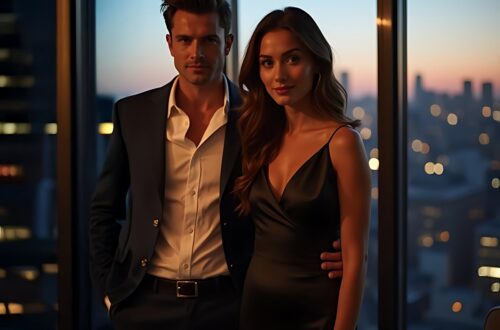
The Power of Visuals: What Hollywood Can Teach You About Personal Image
Before Hollywood rose as the center of the entertainment world, it was nothing more than a 480-acre ranch in the Cahuenga Valley, a typical Californian region full of citrus groves and vineyards.
This agricultural property quickly transformed into real estate development and, in 1910, merged with the expanding city of Los Angeles. Just one year later, the Nestor Company established the first film studio in 1911, marking the beginning of a new era.
Once just a neighborhood on the sunny West Coast, it has since evolved into a dominant force shaping global entertainment. The heart of a multi-billion-dollar industry has become synonymous with the American Dream.
Crucial Role of Costume Design and Compelling Visuals
Hollywood’s financial success relies heavily on compelling visuals, which go beyond what you see on the screen. With money coming from the box office, streaming services, merchandising, licensing, soundtracks, tie-in novels, and theme parks, these visuals boost audience interest and enhance the viewing experience. Boring, low-quality images lead to lower turnout and a decline in profits.
The film industry, like many others, capitalizes on the inherent human tendency to judge based on appearance. However, movie producers didn’t invent the concept of beauty standards; they simply use them to their benefit.
From casting choices to production design, Hollywood thrives on aesthetics.
Costumes and physical appearance are some of the main key aspects of making a movie that sells. Effective design not only helps with storytelling and shapes character development but also influences marketing and branding efforts. Blockbusters aren’t created by coincidence.
Just as in the movie studios along the sunny shores of California, where image is necessary to achieving success, looks play a significant role in your daily life too. While many may claim that it shouldn’t matter and that it’s unfair to make assumptions, the multi-billion-dollar film industry tells a different story.
Instead of dismissing its importance, it’s in your best interest to leverage it to your advantage.
Here’s a breakdown of how character design helps Hollywood maintain and grow its worth, and how your personal image can redefine how you are perceived by others.
1. Enhancing Storytelling and Character Development
Costumes are essential in bringing characters to life. They communicate traits, emotions, and narratives even without dialogue. A well-designed wardrobe reflects personality, social status, development, and even values, aspirations and beliefs.
However, ‘well-designed’ doesn’t mean intricate details or complexity of the costume. It must be well thought through, clearly representing who the characters are and how they are changing. The iconic Danny Zuko, played by John Travolta in Grease, wears a black leather jacket, while his movie love interest, Sandy Olsson, portrayed by Olivia Newton-John, is often seen in pastel, conservative dresses and cardigans. At first glance, the audience can easily guess who is already the rebel and who will become one as the story unfolds.
Off-screen, in the real world, it’s no different. The clothes you wear tell a story about you.
There might be someone who hasn’t evolved from their teenage years of wearing graphic T-shirts and colorful sneakers, or someone who has switched from cheap fast fashion to designer brands with visible logos, making sure everyone takes notice. Or perhaps the opposite—a person who values subtlety, steering clear of flashy trends and opting for timeless pieces. It could be the story of someone who doesn’t seem to care about their looks, or a professional adjusting a tie and wanting to be taken seriously.
Regardless, these choices speak volumes about individual priorities, revealing how one wishes to be seen—or not seen—by the world.
The truth is, in many cases, people don’t really think about what they are showing. However, the lack of awareness doesn’t mean there’s no meaning attached to the way they present themselves. That could be the story of being unintentionally clueless.
2. Driving Marketing and Sales
There are several factors that make a hit. An interesting storyline, a star-studded cast, and renowned directors can draw attention, but more often than not, that’s not enough.
Intriguing, beautiful designs also play a significant role. They add to the buzz and anticipation before a film’s release, driving ticket sales. Hollywood studios further capitalize on them by creating extensive merchandise lines. A striking costume often serves as the central image in marketing a film.
One of many examples are well-known Marvel and DC films. Each superhero wears highly distinctive costumes, so it only takes a moment to tell Batman from Spider-Man. These iconic outfits use specific colors, and styles that reflect each hero’s identity, powers, or origin. Consumers are drawn to these characters for various reasons. It could be the cool designs they simply like or the meaningful stories behind each costume and symbol.
No matter why, fans recognize their favorite franchises and want to own items inspired by them in different forms. Toys, clothing, home decor, or accessories like backpacks and phone cases—there are many things they are willing to pay for.
Producers don’t tell a story just for the sake of storytelling; they have specific goals in mind. To achieve these goals, they need brand recognition to successfully sell their work.
When it comes to your personal branding, think of sales and marketing in terms of showcasing what you have to offer in order to gain something valuable. Value may be defined by finding a romantic partner, building a loyal circle of friends, landing a better job, or being wealthy.
Maybe the clothes you wear clearly communicate who you are and what you want in life. However, if your appearance doesn’t align with your character or aspirations—perhaps because you haven’t given it much thought—it could lead to missed opportunities.
We tend to attach positive traits to those who are physically appealing. Attractive people are perceived to be more intelligent, funnier, competent, and generally more likable. In psychology, this phenomenon is known as the “halo effect”.
It’s worth to notice that attractiveness isn’t just about fitting traditional beauty standards; it’s a combination of multiple factors that signal appeal. Physical features may play a role, but equally important are elements like dressing well, having good posture, and being well-groomed. These signals often suggest self-care, confidence, and social awareness.
3. Increasing Prestige
While marketing uses various promotion strategies, sales is focused specifically on transactions and closing deals, prestige relates to the overall reputation and status of a brand or product.
Hollywood places a high value on critical acclaim, awards, as well as recognition. Costume design is one of the key categories in prestigious ceremonies like Oscars. Winning or even being nominated for an award increases the visibility of a movie, enhancing its reputation and often boosting its box office or streaming numbers.
It’s a chance to elevate a film’s status and create long-term cultural relevance. Award-winners like The Great Gatsby, Titanic, and Black Panther show how well-executed costume design contributes not only to the narrative but also to the film’s overall success and legacy.
In both cinematic worlds and everyday life, appearance influences perceptions and has a strong impact on social interactions and dynamics.
Jessica Campbell, professional ice hockey coach and former player, made her debut as the first female coach in NHL history at the start of the 2024-25 season. Standing behind the Seattle Kraken bench in a white tailored suit, she sent a clear message about her professionalism and ambition. Before the game, she said:
“I’m really going to try to honor what it is, because I know, and I definitely understand that the magnitude and the importance of this moment is really important for our game”.
Her presence commands attention from the moment she walks into the rink.
A sharp suit or a polished outfit can make you stand out in a crowd, showing others that you mean business.
However, in the quest for prestige and building your reputation, don’t put yourself in financial trouble by buying expensive clothes. Trendy, designer items won’t automatically create a refined look.
Leveraging Appearance to Your Advantage
In the early days of cinema, movies were a new and experimental form of entertainment, primarily for the working class, as it was inexpensive and accessible. Over time, the industry evolved, and the introduction of the Academy Awards in 1929 marked a major step toward making films more prestigious.
The Oscars were established not only to honor individual achievements but also to raise Hollywood’s overall status. The goal was to improve the industry’s reputation and demonstrate that filmmaking was a legitimate art form, worthy of respect and recognition, not just cheap entertainment.
As the industry evolved and gained more experience, producers began to understand what captivated audiences.
Over time, with more data and insights into what the public find exciting or dull, they have been able to effectively rely on basic psychological principles to market their films. Strategies based on fundamental human behaviors, emotions, and cognitive biases ensured that movies resonated with viewers, built anticipation, drove ticket sales and streaming engagement.
Similarly, by understanding the significance of visuals in your daily life, you can navigate the world more effectively, using your appearance as a tool for personal and professional growth.
The reality is, first impressions are often formed within seconds. On top of that, once we make up our mind, it’s done.
There are many people who are smart, kind, or brave, yet they may not invest much effort into their image. They may be dismissed or overlooked, not necessarily because of their abilities or character, but simply due to how they present themselves.
While it may seem superficial, how you look often shapes the opportunities that come your way—whether it’s networking, job interviews, or forming personal connections. Studies have shown that people tend to trust and gravitate toward those who outwardly exhibit certain qualities, such as confidence or attention to detail.
Character and skills matter. Nevertheless, being mindful of how you present yourself can bridge the gap between your abilities and how others perceive you, helping to create a story you can be proud of.
FAQ
Q: Why is costume design important in Hollywood?
A: Costumes reflect a character’s personality, social status, and emotional journey, allowing audiences to better understand the narrative without words. They are also essential in marketing, as creating iconic images that attract audiences and boost sales.
Q: How does appearance influence personal branding?
A: Like movie costumes, our appearance communicates how we want to be perceived. Personal branding is about aligning your look with your goals in career, relationships, or social settings.
Q: What impact does appearance have on first impressions?
A: Studies show that first impressions are made in just seconds and are almost impossible to change. A sharp, put-together look can open doors and create positive opportunities, while a sloppy appearance might lead to missed chances.
Q: Can dressing well lead to more opportunities?
A: Yes, dressing well can improve the chances of forming personal and professional connections. Research shows that people are more likely to trust and gravitate toward those who appear confident, detail-oriented, and self-assured.
Q: Why is the “halo effect” significant in Hollywood and in life?
A: The “halo effect” refers to the phenomenon where attractive people are often perceived as more intelligent, capable, or likeable. In Hollywood, well-designed costumes enhance a character’s appeal and contribute to a film’s success. Similarly, in everyday life, our appearance can shape how others perceive us, even before we speak.
Q: How do costumes contribute to a movie’s prestige?
A: Costumes are crucial in creating a film’s legacy and achieving recognition. Winning awards like the Oscars for costume design enhances a movie’s reputation and cultural relevance, elevating both critical acclaim and box office success.




